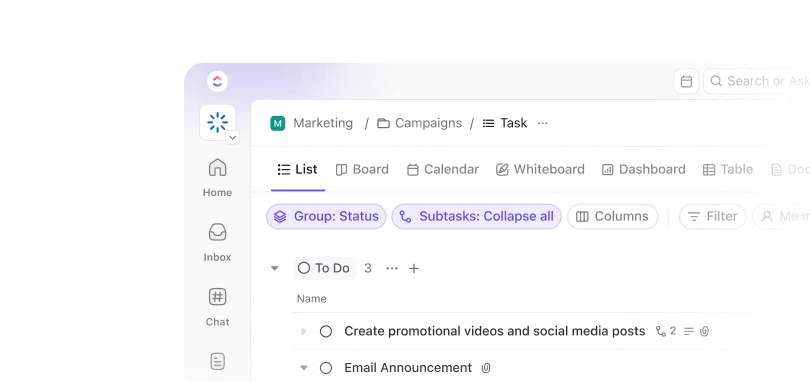You spend months building a strategic plan, but when it comes to execution? Your approach feels generic or slow to pivot.
Only 43% of executives believe their company is good at evaluating how well it can carry out its strategy.
This is the exact gap that kills momentum and leaves you feeling like you’re fighting an uphill battle.
In this post, you’ll discover how leading organizations use industry-specific playbooks to close those gaps.
We’ll define what a strategic execution playbook really is, show you why tailoring it to your industry matters, and how modern tools (yes, including ClickUp) and AI can help.
We’ll also walk you through proven components of these playbooks, and share case studies so you can see what works in healthcare, finance, manufacturing, SaaS, and more.
So, if you want strategic initiatives that aren’t just pretty documents but deliver real business outcomes, keep reading.
- What Are Strategic Initiative Playbooks?
- Why Industry Context Matters in Execution
- Playbooks by Industry: Best Practices
- Components of an Effective Playbook
- How AI Enhances Industry-Specific Playbooks
- Step-by-Step: Building an Industry-Specific Playbook with ClickUp
- Common Mistakes in Industry-Specific Initiative Execution
- Case Studies: Strategic Initiatives by Industry
- The Future of Industry-Specific Playbooks
- Turning Static Strategy into Evolving Execution with Industry-Specific Playbooks
- Frequently Asked Questions (FAQs)
What Are Strategic Initiative Playbooks?
A strategic initiative playbook is a structured, repeatable framework combining workflows, best practices, roles, Key Performance Indicators (KPIs), and tools designed to guide the execution of strategic initiatives so that “what works” in an industry becomes a replicable model.
What is the difference between a generic strategy framework and an industry-tailored playbook?
In a nutshell, a generic corporate strategy framework offers high-level guidance applicable everywhere (e.g. SWOT, OKRs, Balanced Scorecard), while an industry-specific workbook embeds industry-specific constraints, norms, regulations, customer behavior, tech stack, and performance benchmarks into the mix.
Here’s a head-to-head comparison:
| Feature | Generic strategy framework | Industry-tailored playbook |
| Scope of guidance | Broad, high-level: company’s vision, mission, goal types | Specific execution paths, industry best practices, strategic partnerships, regulatory & compliance workflow |
| Benchmarks & KPIs | General or averaged across industries | Benchmarks tuned to your sector (e.g. finance: margin/regulatory KPIs; healthcare: patient outcomes, safety) |
| Tools & templates | Standard tools, generic templates | Specialized templates and tool combinations aligned with your industry workflows and tech stack |
| Risk & compliance considerations | Minimal; generic risk treatment | Deeply embedded risk controls and compliance checks that matter in your domain |
| Speed & adaptability | Slower to adapt, more theoretical | Faster to implement because it can be adjusted to industry volatility and change cycles |
Why Industry Context Matters in Execution
When you adopt a strategic initiative without accounting for your industry’s realities, you risk missteps that cost your company time, money, and morale. These four dimensions show why tailoring your playbook to your sector is crucial:
Regulatory and compliance considerations
Healthcare systems must manage HIPAA or equivalent privacy rules, while finance firms juggle Basel III, Dodd-Frank, GDPR, etc. In such deeply regulated industries, missing a rule isn’t a casual slip-up. It can result in fines, reputational damage, or worse for your business.
👀 Did You Know? In 2023, regulators globally fined financial institutions $6.6 billion for non-compliance with AML (anti-money-laundering), KYC (Know Your Customer), sanctions, and related rules.
Customer expectations and market pace
Customers in SaaS expect continuous updates, fast feedback loops, flexible pricing, and rapid feature delivery. Meanwhile, manufacturing customers are more sensitive to product quality, safety, uptime, delivery timelines, and supply chain reliability.
The global SaaS market is growing at roughly 18-20% CAGR in many sectors, while many manufacturing segments see slower growth and higher capital investment cycles.
If your company’s strategy playbook treats both like they move at the same speed, you’ll overcommit in some areas or underdeliver in others.
Organizational culture and workforce readiness
Even the best strategy fails if people aren’t ready. Culture shapes how quickly teams adopt change, how they communicate risk, and whether they assume responsibility.
A recent study in IT found that a supportive work environment and a learning-org culture significantly boost innovation and performance. If your people aren’t upskilled, incentivized, or psychologically safe, then playbooks that assume high agility or digital fluency will stall.
Competitive and technological landscape
The playing field differs across industries. You’ve got to factor in your competitors, the tools available to you, and the tech you can leverage.
📌 For example, in finance, continued digitization (AI, RegTech, real-time monitoring) is becoming table stakes. In manufacturing, automation, IoT, and predictive maintenance are shifting where value lies.
If your playbook ignores innovative strategies competing firms are following, the tech platforms that are maturing, or the disruptions that are emerging, you’ll likely execute initiatives that are obsolete by the time they’re done.
With these critical differences mapped out clearly, you can tailor your strategic playbook to align more closely with your industry dynamics and your organization’s goals and execution capabilities.
Playbooks by Industry: Best Practices
Here are what industry-specific strategic initiative playbooks look like in practice, with examples of success, so you can see what really works. And use these as models you can adapt.
Healthcare
⚠️ The problem:
Healthcare orgs often struggle to stay patient-focused while juggling rules, data privacy, and fragmented patient journeys. Departments work in silos (clinical, IT, operations), so efforts to improve care get bogged down in handoffs, delays, or a complete misunderstanding of patient needs.
✅ What works:
- The KLAS Playbook for Patient-Centric Care (2025) outlines four strategic tracks: breaking down barriers to patient care, personalizing care, empowering patients via access, and using proven best practices. What makes it effective is that it doesn’t just say, “Be patient-centric.” It shows how, with steps like mapping patient journeys, soliciting real feedback, adjusting workflows, updating IT systems for personalization, etc.
- Also, the federal Patient Engagement Playbook helps healthcare practitioners ramp up patient portal adoption by simplifying enrollment, integrating portal use into visit workflows, training both staff and patients, and tracking adoption over time. The key is embedding the engagement tools into existing clinical operations rather than treating them as bolt-ons
⚡️ Why it works:
- Because patient-centric playbooks force you to align what patients actually experience (not what org charts think) with your internal systems
- Embedding compliance and privacy up front prevents rework and resistance
- Cross-department work ensures that digital tools, care protocols, and feedback flow through all touchpoints (nurse, doctor, front desk, billing) so quality doesn’t degrade at handoffs
Finance
⚠️ The problem:
Financial firms often face volatility, strict regulations, pressure from consumers for transparency, and the need for speed. They risk falling behind when they adopt generic risk or compliance frameworks that don’t reflect their specific regulatory environment or customer trust needs.
✅ What works:
- Strong risk and compliance workflows: Firms investing in regulatory technology (RegTech), real-time monitoring, and model governance can reduce exposure. With clear audit trails and risk reviews embedded into product development and customer interactions, they can strengthen compliance and build lasting confidence among regulators
📌 Example: Mashreq Bank, a major bank in the United Arab Emirates, faced more fraud as digital payments soared during the pandemic. To stop scams from customers, employees, and outsiders, they used Clair5, a real-time fraud detection system.
Clair5 monitors transactions across all channels every 2 minutes, using over 50 preloaded fraud scenarios that update automatically. It works smoothly with the bank’s main systems, using less than 1% of CPU resources.
The result: faster fraud detection, fewer losses, and safer banking for customers, plus useful insights into financial trends.
- Consumer trust-building measures: Transparency about fees and data privacy can strengthen customer trust. Clear communication when issues or delays happen (for instance, during market turbulence) is also a non-negotiable. This is why firms often set up public dashboards or issue regular, public-facing trust reports
Nearly two-thirds (65.8%) of U.S. consumers said that a company being transparent about how it plans to use personal data would help that company gain their trust.
⚡️ Why it works:
- Because financial regulation is unforgiving: getting it right the first time lowers risk
- Embedding risk and compliance workflows means you don’t slow things down later. It’s cheaper to design with compliance than to retrofit measures in existing systems
- Transparency builds trust, which in finance becomes a competitive differentiator. When customers believe you’re trustworthy, you’re less likely to face backlash (legal or reputational) when things go sideways
Technology/SaaS
⚠️ The problem:
The tech/SaaS world moves at lightning speed. If your strategic initiative is slow, overplanned, or disconnected from product usage, you’ll get outpaced. Generic strategies often assume stable markets; SaaS requires rapid iteration, near real-time feedback, and a focus on user-centric metrics.
✅ What works:
- Product-led growth (PLG): Let users self-serve, trial, or have freemium paths, using usage data to drive improvements
- Rapid Go-to-Market (GTM) cycles: Break work into small increments and sprints to be able to ship faster. Then, measure reception and customer sentiment early, deploy updates fast, and keep learning and adjusting as the market evolves
- Experimentation culture and feedback loops: A/B testing, user feedback, telemetry, and real-time analytics can be strong pillars for your strategic SaaS playbook
📌 Example:
The above strategic playbook is part of what propelled ClickUp to 20 million users worldwide and an ARR of $300 million.
A little bit of context:
Teams today are drowning in disconnected tools—chat apps, project trackers, document editors, dashboards—each promising productivity but creating endless context-switching and Work Sprawl. Users want simplicity: a single platform that understands context and reduces friction.
At the same time, every major SaaS product is embedding AI, hoping to boost efficiency. But AI without context is just another layer of noise.
ClickUp saw the opportunity: by creating the world’s first Converged AI Workspace, we integrated over 50 tools into one platform, embedding Contextual AI that understands users’ tasks, docs, chat, and dashboards without requiring them to switch dozens of tools to get the job done.
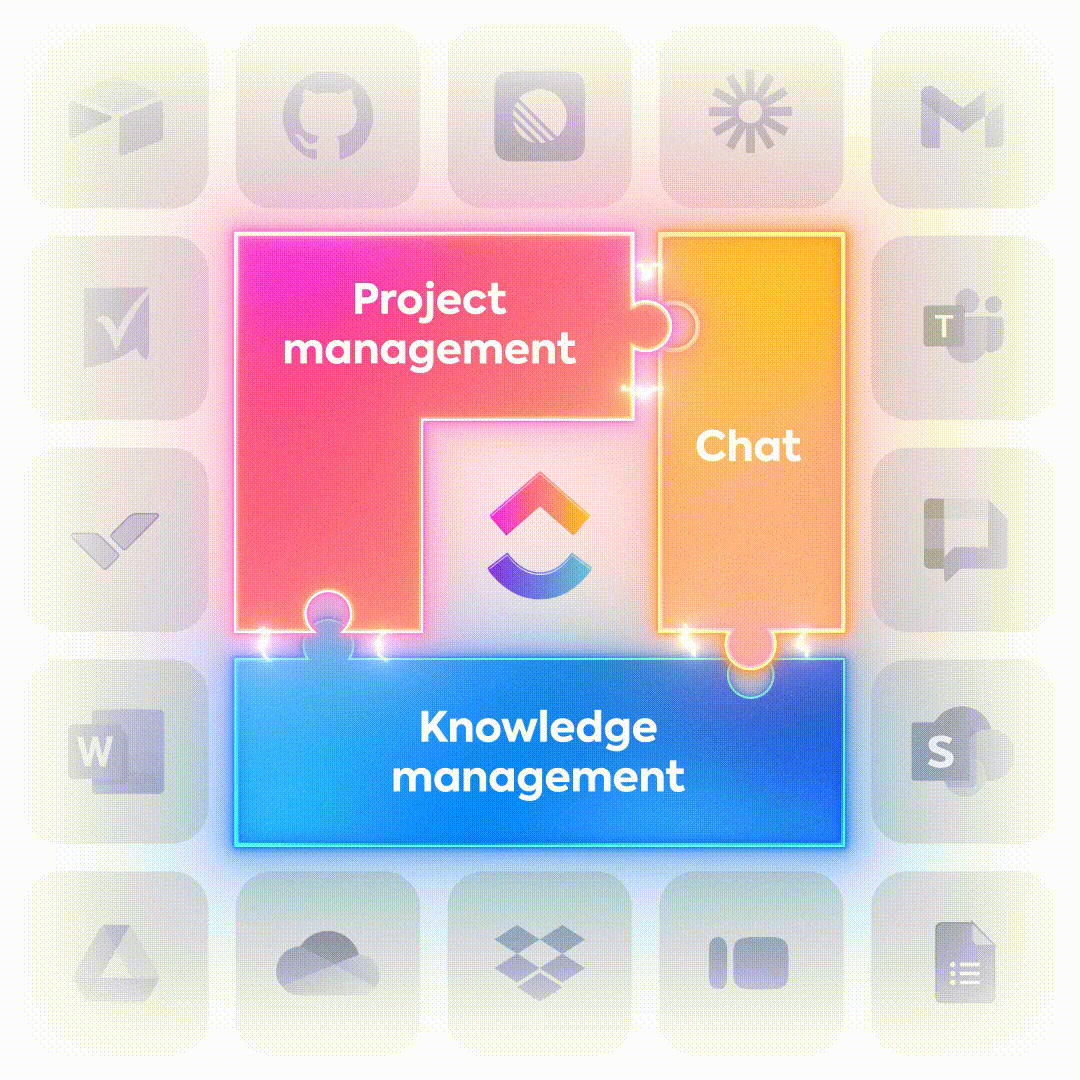
This timing was perfect. Teams already expected AI, and they were frustrated with fragmented systems. This approach enabled us to capitalize on these trends.
By combining AI, context, and speed, ClickUp has turned a crowded market into a competitive advantage, proving that the right product, at the right time, with the right playbook, can reshape how teams work.
📚 Also Read: How ClickUp’s Marketing Team Uses ClickUp
📌 Another example:
Language-learning platform Duolingo leans heavily into usage analytics and experiment-driven product improvements. Between 2018 and 2022, the company achieved a 4.5x increase in daily active users (DAUs) by focusing on enhancing user retention through small, iterative product changes.
- Duolingo prioritized the Current User Retention Rate (CURR), discovering that a 2% monthly increase in CURR led to a 75% rise in DAUs over three years
- Gamification elements and features like streaks, leaderboards, and personalized notifications were optimized through A/B testing, significantly boosting user engagement
- The team conducted over 600 experiments, refining features based on user feedback and behavior, which contributed to a 350% growth acceleration
⚡️ Why it works:
- Because speed + feedback are survival in SaaS. A misassumption uncovered early costs far less than one discovered after months of development, wasted marketing spend, or a failed launch
- When your GTM cycle is fast, you can pivot equally fast if market or customer expectations shift
- Data-driven product changes reduce waste; product-led models align growth with product quality rather than just sales/marketing spend
📚 Also Read: How to use AI for Marketing Automation
Manufacturing
⚠️ The problem:
Manufacturing initiatives often encounter friction due to supply chain uncertainties, outdated or legacy equipment, and reliance on manual handoffs. They also struggle with poor visibility across processes and inefficiencies in inventory management, logistics, and quality control.
In many cases, each plant or facility is treated as its own isolated island, which makes coordination and standardization across the entire organization even more difficult.
✅ What works:
- Lean processes: Companies can work smarter by cutting out waste and doing things the same way across all plants. Techniques like Just-In-Time (JIT) mean you only make or store what’s needed, when it’s needed. And small, constant improvements— Kaizen—help employees spot ways to make work easier and faster over time
- Improved supply chains: Knowing exactly where parts and materials are helps things run smoothly. Having backup suppliers (dual sourcing) and a bit of extra stock for emergencies makes sure nothing stops production. Predictive analytics can even forecast problems before they happen, like when demand will spike or a shipment might be delayed
- Automation and AI: Automation and AI can take on repetitive tasks so humans don’t have to, which reduces mistakes. AI can also warn if equipment might break soon, so repairs happen before catastrophic problems arise. Real-time dashboards and automatic ordering keep track of inventory and make sure everyone knows what’s happening, fast
📌 Examples:
- LynnCo, a team of logistics experts, worked with a glass manufacturer that had issues with shipping reliability, cost overruns in logistics, and heavy delays. They created a supply chain optimization playbook that involved streamlining communication & process flows among key stakeholders, more precise routing, pooling shipment points, and better contracted terms. The results of the strategic do-over: 34% annualized logistics cost savings; 100% on-time delivery; and improvements in process flow by ~57%
- Manufacturers across various industries are increasingly integrating AI and robotics into their day-to-day operations to enhance efficiency and scalability. Companies like Bausch + Lomb, Spot & Tango, Prose, and FranklinWH have adopted AI technologies in their new facilities to improve production processes.
- Bausch + Lomb implemented the Atlas AI system from Arena AI to predict machinery issues and scale up contact lens production
- Spot & Tango adopted agentic AI from Didero to automate aspects of its supply chain, automating 60% of purchase orders at its Pennsylvania facility
- Prose used AI and autonomous robotics to reduce shampoo production costs by $4 per unit, with 90% of operations now automated
- FranklinWH introduced AI-enabled visual inspection and predictive quality monitoring at its California home battery plant
⚡️ Why it works:
- Because manufacturing margins are tight and small inefficiencies cascade into big costs
- Visibility into supply chain + operations means you can diagnose where delays or waste are happening
- Automation & lean practices standardize, reduce variation, and push responsibility downstream (towards where the work is done), making quality better
🧠 Fun Fact: 77% of manufacturers plan to increase AI investments in 2026.
Education
⚠️ The problem:
Education systems trying to modernize often face resistance from both faculty and students. Uneven resource allocation and infrastructure challenges make execution harder, as do digital literacy gaps and alignment issues (funding, policy, mission).
Often, digital initiatives are layered on without adjusting pedagogy, evaluation, or support.
✅ What works:
- A strong focus on capacity building: Train teachers/faculty to use new tools, change pedagogical methods, and provide support
- Aligning reform with mission + funding + policy: Digital transformation should connect to what stakeholders care about (student outcomes, employability, funding accountability)
- Hybrid/blended models: Use EdTech not as an add-on, but integrate it into the daily learning, assessment, and administrative workflows
📌 Examples:
- The EHL Hospitality Business School rapidly transitioned to online education during the COVID-19 lockdowns. They delivered over 7,000 hours of online lessons and administered more than 12,000 online exams across 90+ countries within just 12 weeks. Prior to the pandemic, EHL had already been integrating digital tools and blended learning approaches into their curriculum. So, this wasn’t just an emergency response; the institution turned this into a permanent change with blended formats, online resources, and virtual campus visits becoming part of the long-term business strategy
- The PAL (Personalised Adaptive Learning) program in Andhra Pradesh, India: Students involved in PAL across 1,224 government schools gained 1.9 years’ worth of learning in just 17 months, compared with peers. That’s massive. The success came from combining evidence-based tech + strong governance + rigorous monitoring + adaptive content
⚡️ Why it works:
- Because educational transformation succeeds when people feel supported, and not forced. Teacher training & ongoing support reduce resistance and increase quality
- When change aligns with what funders, regulators, and mission leaders care about, it’s easier to get buy-in and access to sustainable resources
- Tech must serve pedagogy, not the other way around. Tools are powerful, but their impact is limited unless they map to how students learn, how assessments are done, and how faculty work
Components of an Effective Playbook
A playbook is only as good as the pieces inside it.
Here are the five components that actually move the needle—what each one should contain, why it matters, and quick tips so you can put them into practice today.
Vision and strategic-alignment framework
Start with a crisp answer to “why this matters now” and link that to measurable outcomes. Your strategic vision should say what success looks like in numbers and timeframes (e.g., reduce churn by 15% in 12 months, or cut operating costs by 8% in Q3). That alignment gives every team a north star.
When people know the measurable outcome, they prioritize ruthlessly and avoid “pet projects” that distract execution.
Quick wins to implement:
- Convert one strategic goal into 3–5 measurable outcomes with owners and deadlines
- Tie one KPI on your existing dashboard to exec review cadence (weekly or biweekly)
💡 Pro Tip: Use the ClickUp OKR Framework Template to link strategic tasks and projects to specific outcomes, providing real-time visibility for executives and teams alike.
Stakeholder mapping and communication plan
Map who cares about what, how much influence they have, and how they like to receive information. Focus on both internal stakeholders (executives, ops, frontline teams) and external ones (regulators, partners, customers). Also, decide the cadence you’ll use for each. Then make a clear communication plan that reflects these decisions.
Having a deliberate stakeholder strategy prevents surprises and builds the political runway your initiative needs.
👀 Did You Know? As a CEO who listens to frontline employees, you’re 80% more likely to put better ways of working into practice.
Quick wins to implement:
- Build a 1-page stakeholder matrix (name, interest, power, preferred channel) and share it in the kickoff doc for your strategic initiative
- Schedule two low-effort, high-value touchpoints (e.g., a fortnightly one-pager to the board and a 15-minute weekly standup with the ops lead)
💡 Pro Tip: Use ClickUp Brain, the world’s most complete and contextual Work AI, to auto-draft your standup reports based on the project data in your workspace. Brain understands your Tasks, Docs, and Chats in ClickUp to surface the key updates, without you needing to cobble it together manually.

Execution roadmap with milestones and KPIs
Break your playbook into time-boxed phases with clear milestones and success metrics. Don’t confuse activity for progress: list the deliverables, the owner, the acceptance criteria, and the KPI tied to business value. You can also use rolling 30-/60-/90-day plans so you can adapt without losing momentum.
Quick wins to implement:
- Convert an ambiguous deliverable into a “done” checklist + KPI (e.g., “Customer onboarding flow live — <5% drop in activation at step 2”). ClickUp’s Task Checklists can come in handy here

- Publish a living roadmap in a shared workspace like ClickUp so everyone can see progress and blockers in real time
Risk and compliance guardrails
List the must-have controls: legal/regulatory checkpoints, data handling rules, approval gates, and who signs off. Make these guardrails part of the workflow (not a separate checklist you forget). Where possible, automate evidence collection, including logs, versioned approvals, and traceable decision records.
Why does it matter?
The cost of non-compliance keeps rising; firms face meaningful fines and reputational damage when controls are only afterthoughts.
Quick wins to implement:
- Add a compliance “must-pass” checklist to the relevant templates for your initiative and automate a copy of approvals into a compliance folder
- Identify one manual compliance step and automate evidence capture (audit logs, time-stamped approvals, etc.) this quarter
👀 Did You Know? You can rely on smart AI agents such as ClickUp’s Ambient Agents to automate specific parts of compliance workflows within your organization. ClickUp Agents can be programmed in natural language to track and log actions taken during critical workflows, creating a comprehensive audit trail that simplifies compliance reporting and reduces the risk of human error.
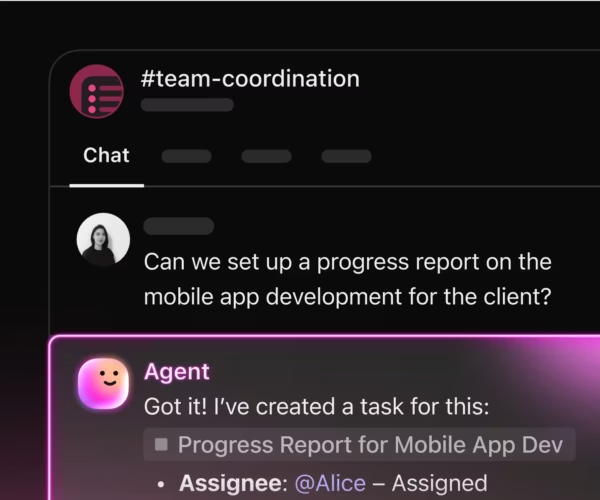
📍 For example, imagine a healthcare services firm that manages patient data across multiple clinics. Every week, dozens of approvals, record updates, and compliance checks happen across different team—from admin staff to medical officers. Keeping track of who did what (and when) would mean endless spreadsheets and late-night audit prep.
With ClickUp Ambient Agents, the firm automates much of that process. The agent automatically logs every approval, note, or update related to patient records—capturing timestamps, users, and context in a summary—without anyone having to lift a finger. During audits, compliance teams can instantly pull verified records instead of piecing them together manually.
Feedback loops and iteration cycles
Want to reduce failure rates and speed up learning? Data-driven feedback loops might be your key.
Identify who collects feedback, how often, where it’s stored, and how decisions are made based on it. You’ll be looking at customer signals (NPS, support tickets), operational telemetry (cycle times, error rates), and qualitative checks (focus groups, frontline notes) alike.
🤝 Friendly Reminder: Set a rhythm so feedback and iteration aren’t one-and-done tasks. Based on your workflows, you can set up weekly checks, monthly reviews, and quarterly strategy adjustments.
Quick wins to implement:
- Pick one signal you already have (support ticket volume, activation rate) and add it to a weekly mini-dashboard in a tracking tool like ClickUp Dashboards. Make one small change each week and measure the effect
- Run a 2-week learning sprint after the first milestone: capture hypotheses, experiments, outcomes; then decide which experiments to scale
Pulling it together—an operational checklist (30-minute setup)
If you have half an hour, you can create a skeletal playbook that will make the rest of your execution smoother:
✅ Write one measurable, compelling vision statement (5 minutes)
✅ Draft a one-page stakeholder map (10 minutes)
✅ Convert the top deliverable into a milestone + KPI (5 minutes)
✅ List 3 compliance checkpoints and assign owners (5 minutes)
✅ Decide on one feedback signal and add it to your dashboard (5 minutes)
This 30-minute scaffold will stop you from making the common mistake of starting with tactics before you’ve aligned on outcomes and governance.
How AI Enhances Industry-Specific Playbooks
AI isn’t just a buzzword. When used carefully, it sharpens playbooks and surfaces signals you’d otherwise miss. Here are four ways AI adds leverage:
Predictive analytics for risks and opportunities
Predictive AI models can analyze historical data and external signals (market opportunities and threats, customer behavior, and other key indicators) to flag risks before they become crises or spot opportunities earlier than competitors.
~71% of firms using AI-powered predictive risk assessment believe that Natural Langauge Processing (NLP) technology fast-tracks the process of identifying emerging risks, while ~71.5% believe its accuracy is higher when compared to traditional methods.
Key takeaways you can implement right away:
- Train your predictive model on domain-specific historical data (not just generic): e.g. finance transaction logs, healthcare patient flow
- Include external data (regulation changes, market shifts, macro-economic) to avoid tunnel vision
- Use predictions early in the roadmap so you can build in risk-mitigation steps (workforce, budget slack, etc.)
AI-powered dashboards tailored by industry KPIs
Dashboards enhanced with AI do more than show status; they alert you to anomalies. Use them to compare performance vs. benchmarks so you can spot downward trends before they’re visible to the naked eye.
The best part? These dashboards can also suggest corrective actions.
💡 Pro Tip: Use AI Cards in ClickUp Dashboards to translate raw data into a narrative. Cards like AI Brain, AI Executive Summary, and AI Project Update, etc., can run custom prompts (e.g., “What are the major risks & blockers?”) to give you summarized insights on your strategic initiatives and highlight room for improvement.
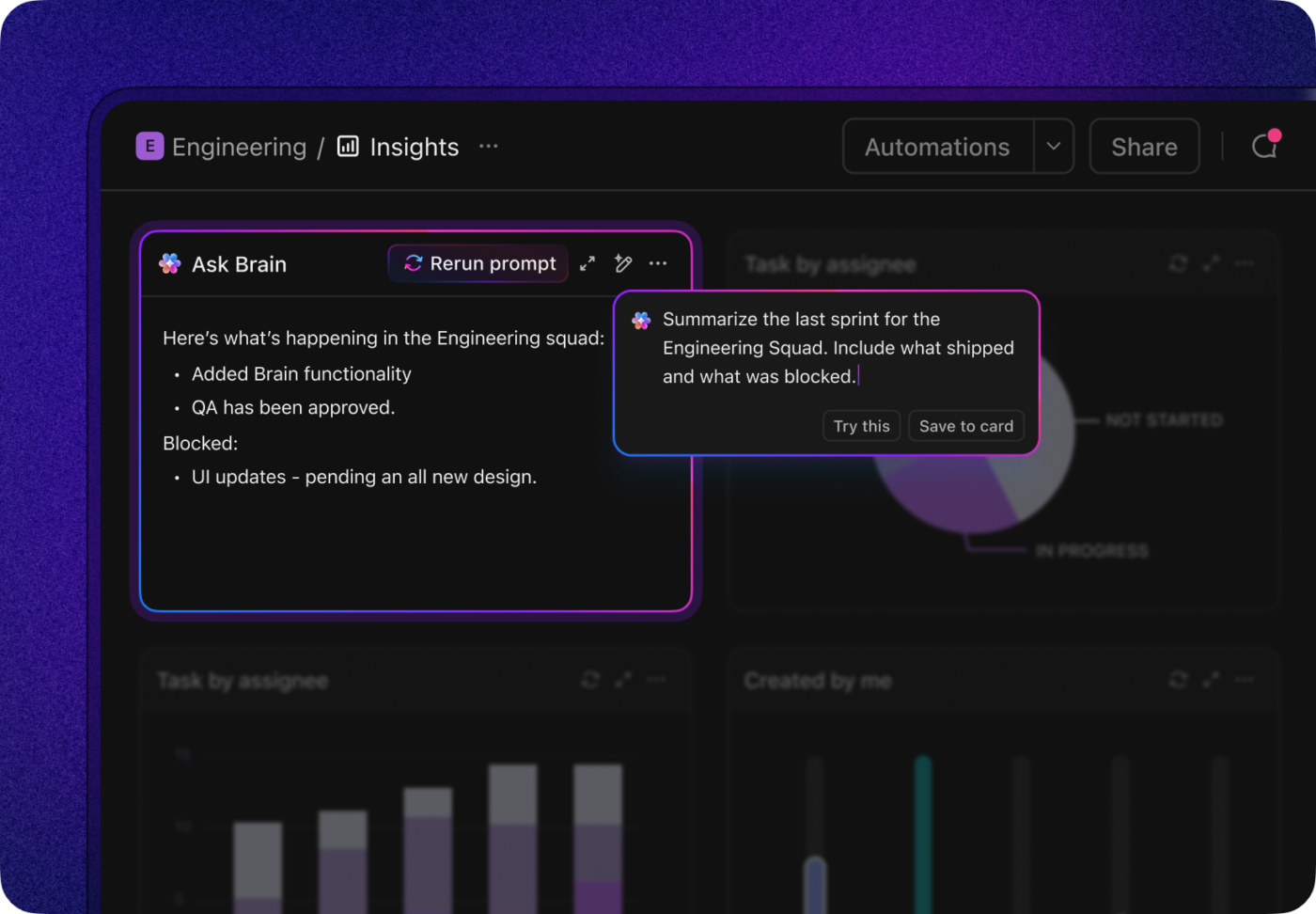
Key takeaways you can implement right away:
- Always define which KPIs matter for your industry/initiative (not generic or vanity metrics)
- Automate data flows so dashboards are as live as possible—stale data kills credibility
- Include alerts & anomaly detection so you don’t wait for monthly reports to see when things go off course
- Make dashboard views role-appropriate (execs see high-level trends; operators see detailed performance
Automated workflows (approvals, compliance checks, reporting)
When your best people are caught up in busywork, it slows down strategic execution. Incorporating AI and workflow automation can reduce manual error, improve consistency, and free up your people to do more meaningful work.
Key takeaways you can implement right away:
- Map out your workflow steps to check where approvals are needed, where data must be checked, and who’s responsible for execution
- Automate the non-judgment parts (data checks, basic approvals, compliance for standard cases)
- Use AI/rules engines to flag when something deviates (e.g. compliance thresholds, budget overruns)
- Ensure audit/rule trails. When something is automated, you still need a transparent record
📮 ClickUp Insight: 21% of people say more than 80% of their workday is spent on repetitive tasks. And another 20% say repetitive tasks consume at least 40% of their day.
That’s nearly half of the workweek (41%) devoted to tasks that don’t require much strategic thinking or creativity (like follow-up emails 👀).
ClickUp AI Agents help eliminate this grind. Think task creation, reminders, updates, meeting notes, drafting emails, and even creating end-to-end workflows! All of that (and more) can be automated in a jiffy with ClickUp, your everything app for work.
💫 Real Results: Lulu Press saves 1 hour per day, per employee using ClickUp Automations—leading to a 12% increase in work efficiency.
Sentiment analysis to measure cultural adoption of initiatives
Sentiment analysis uses text/feedback sources such as surveys, social/internal forums, support tickets, chats, to gauge how people feel about change. When organizations track employee sentiment toward transformation initiatives (via internal channels or surveys), they can identify resistance pockets early.
Ultimately, cultural adoption isn’t just “Did they attend the training?”, but “Do they believe this change makes sense, trust it, and are they using it?”
Key takeaways you can implement right away:
- Collect feedback regularly via multiple channels (anonymized surveys, forums, peer groups, internal chat)
- Use sentiment analysis tools to flag themes (e.g. “frustration with the new tool,” “lack of clarity,” “fear of job loss”) rather than just raw positive/negative scores
- Act visibly by showing you listened to the pressing issues and made adjustments. Also, communicate what changed, in order to build trust
💡 Pro Tip: Create a ClickUp Form to gauge employee sentiment easily. Responses auto-convert into actionable Tasks in ClickUp, and ClickUp Brain can even help you analyze sentiment plus suggest corrective actions.
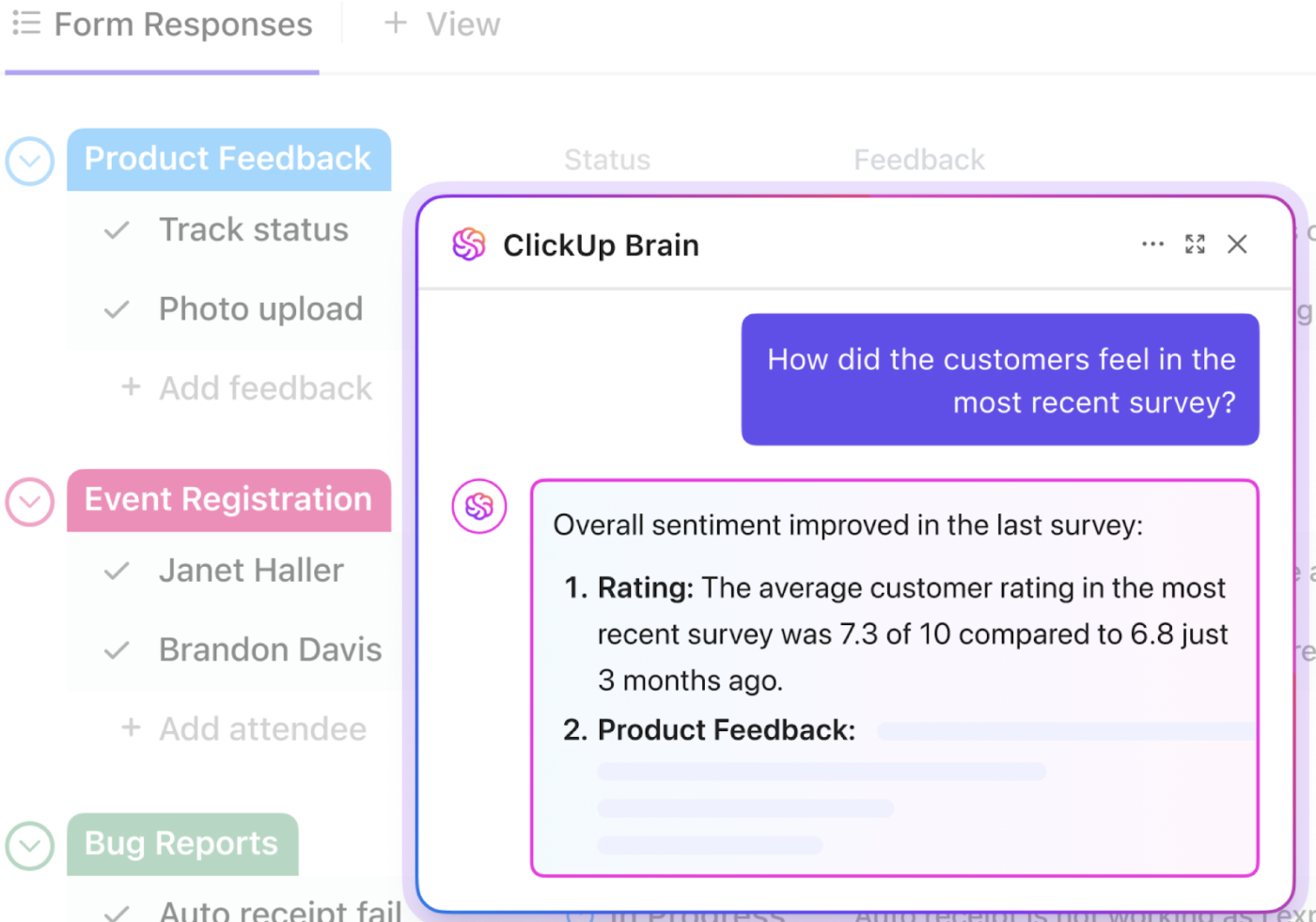
Step-by-Step: Building an Industry-Specific Playbook with ClickUp
Let’s now walk through how you’d build a tailored playbook in ClickUp, from framework to effective strategy execution.
Imagine you’re leading a strategic initiative in a healthcare organization that’s focused on patient-outcome improvements, stronger compliance, and cross-department coordination.
Here’s how the steps would play out.
Step 1: Use ClickUp Docs to standardize playbook frameworks
Start by building your playbook’s foundation in ClickUp Docs.
Docs support nested pages, templates, and rich editing, letting you craft a living “source of truth” that lays out your vision, components, stakeholder plan, and compliance rules in one place, instead of multiple scattered apps.
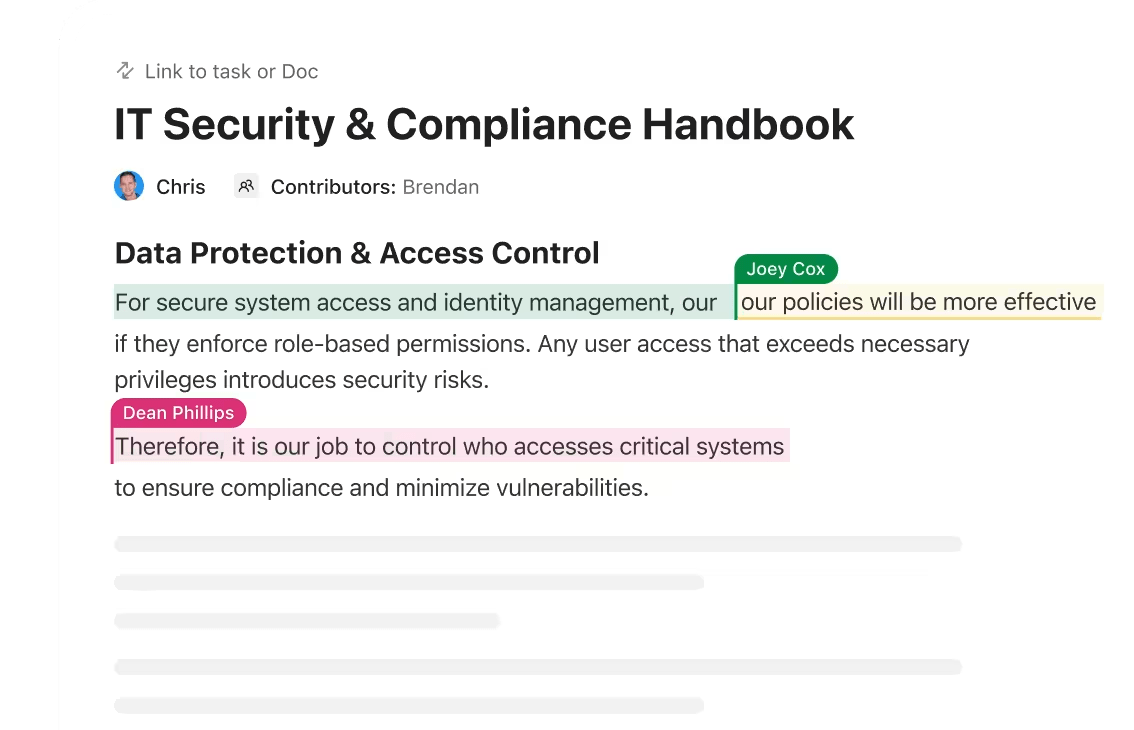
📌 For example, you can create a “Patient Initiative Playbook” Doc with sections like “Vision & KPIs,” “Regulatory Requirements,” “Workflow Maps,” etc.
What makes Docs a better choice for your playbook than other document editors?
You can create and link actionable ClickUp Tasks from right within Docs so your strategy and execution don’t live in separate tools. You can also embed multimedia assets into Docs so your playbook has the complete context your team needs—think explainer videos, reference URLs, and supporting images.
Because Docs connect to tasks and workflows, your playbook never becomes stale.
Plus, with ClickUp Brain right inside ClickUp Docs, you can get from idea to polished content within seconds. Tell Brain the idea and objective behind your strategic initiative playbook and prompt it to give you a first draft for each section, fleshed out with suggestions and best practices tailored for your organization.
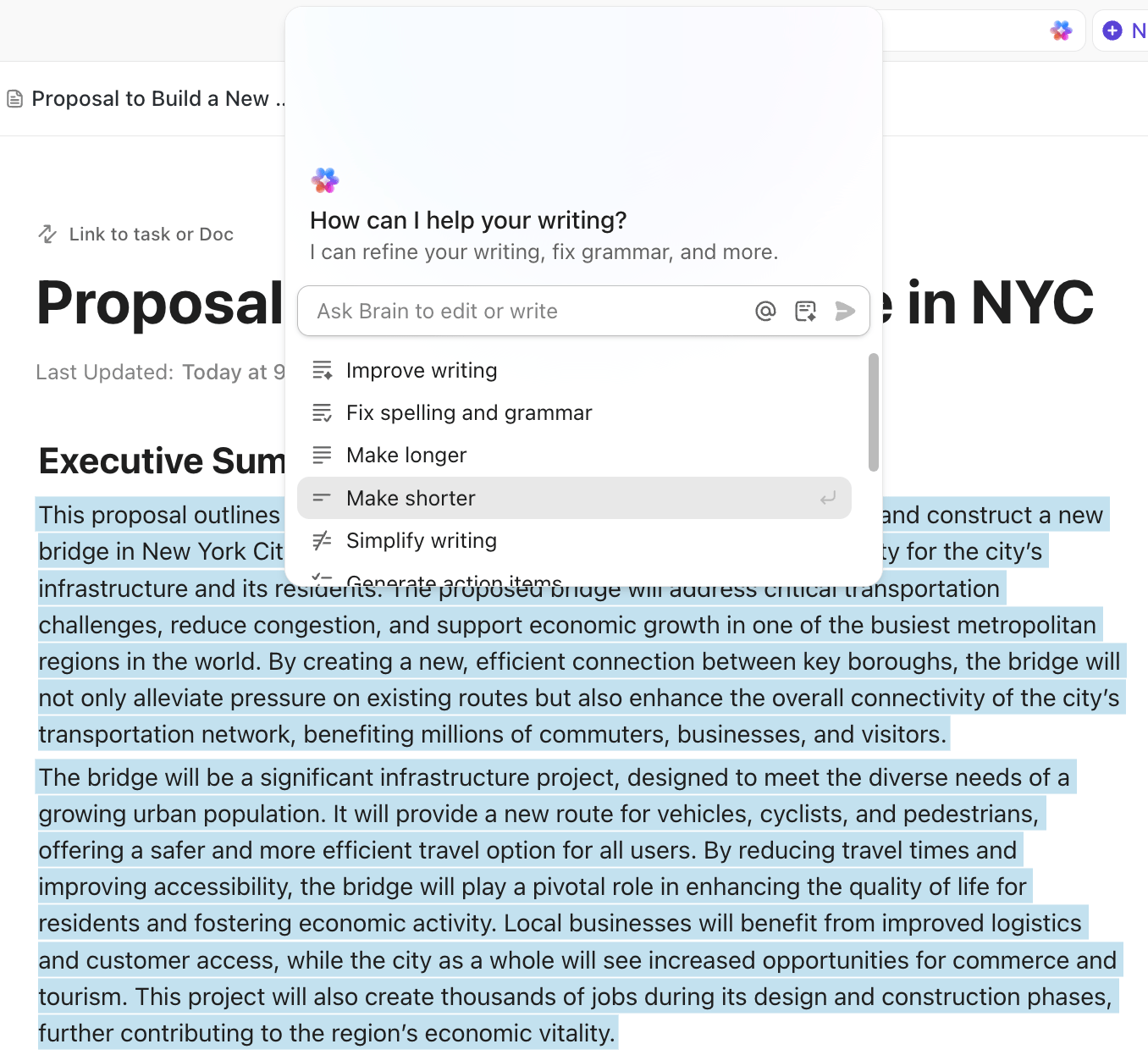
💡 Pro Tip: Save your playbook as a template in ClickUp so future initiatives are able to reuse the same structure and discipline.
Step 2: Map workflows with ClickUp Whiteboards
Next, use ClickUp Whiteboards to visualize how your initiative flows across teams—clinical, IT, compliance, operations. Whiteboards let you sketch processes, map roles, and then convert those nodes into ClickUp Tasks or link them to Docs.
📌 For instance, map a “patient feedback loop” journey on a blank Whiteboard:
Patient completes survey → triggers flag (for negative feedback) → clinical review → operative change → follow-up. As you map each step, convert boxes into tasks with assignees, dependencies, or links.
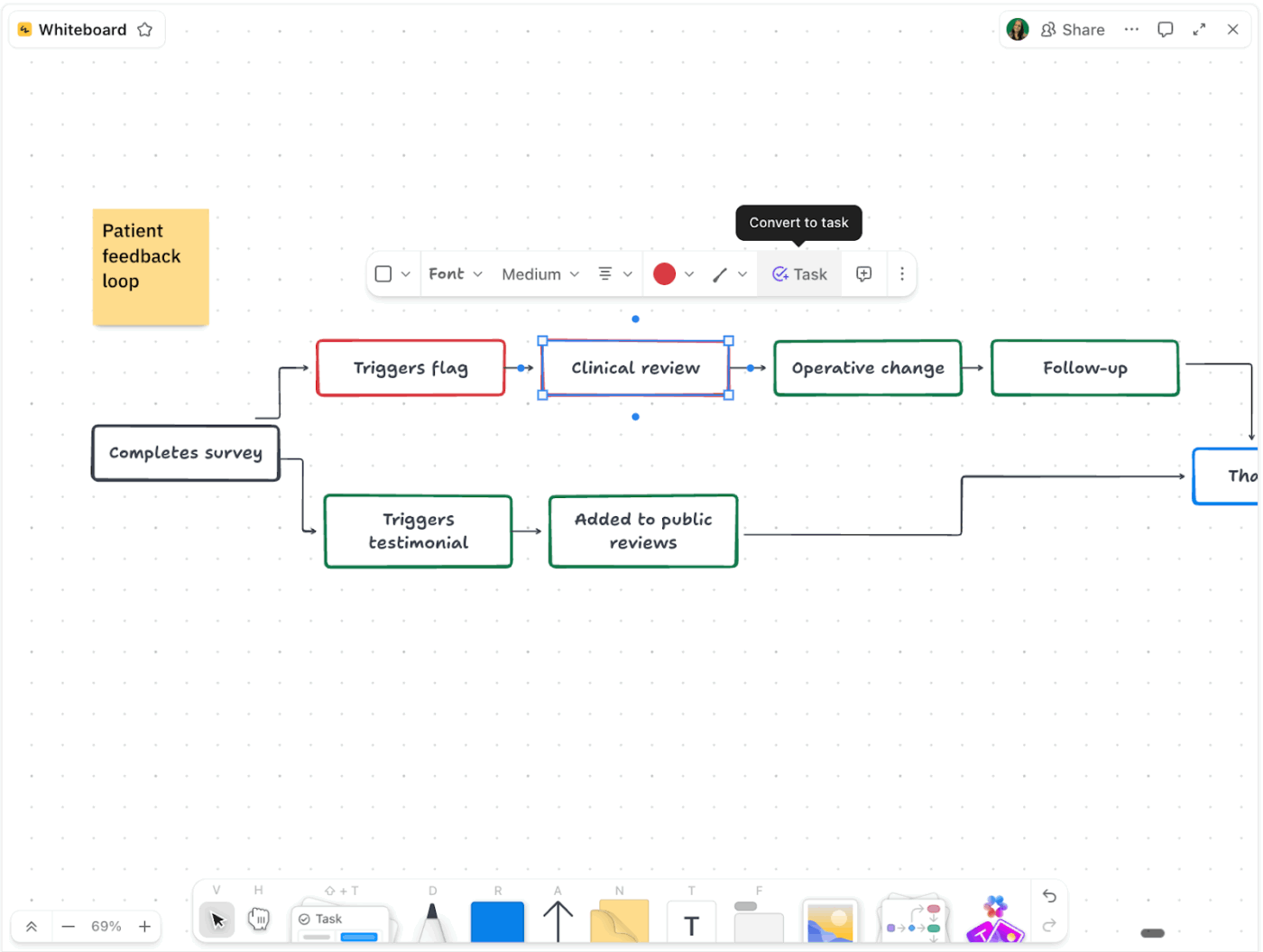
Whiteboards stay tied to the rest of your workspace, so nothing lives in isolation.
This simple exercise will give your team a visual blueprint before project execution while surfacing gaps in handoffs. It’ll also fast-track alignment across departments that often speak different languages.
Step 3: Assign initiatives as Goals and track KPIs
With the structure in place, convert major elements of your playbook into Goals in ClickUp. Goals let you link your work items to measurable targets and outcomes (e.g. “Reduce readmission rate by 8% in 12 months”). That way, individual tasks roll up to strategic metrics.

In our healthcare playbook, the goal-seting strategy should account for categories like “Patient Experience,” “Operational Efficiency,” and “Compliance & Safety.”
Under each, assign ClickUp Tasks to the responsible team members (e.g. “revise discharge protocol,” “audit handoff logs”) and watch how each contributes directly to the strategic objectives. The system auto-tracks progress, so execs see the actual progress live against the planned targets.
💡 Pro Tip: Use AI Assign in ClickUp to automatically pick the right person for the right job while handing out task responsibilities. ClickUp’s smart AI autofills your task priorities by making intelligent decisions based on your inputs—for example, if a Patient Experience task is created where the patient feedback is recorded as negative, always assign it to Clark for follow-up.
Step 4: Automate approvals, compliance tasks, and reminders with ClickUp Automations
Once Tasks are structured, you can also inject automation to reduce friction and delegate the busywork.
ClickUp Automations let you configure triggers, conditions, and actions that auto-execute work for you. For example, “When task status moves to Review → send to compliance reviewer,” or “If due date is 3 days overdue → escalate to manager.”
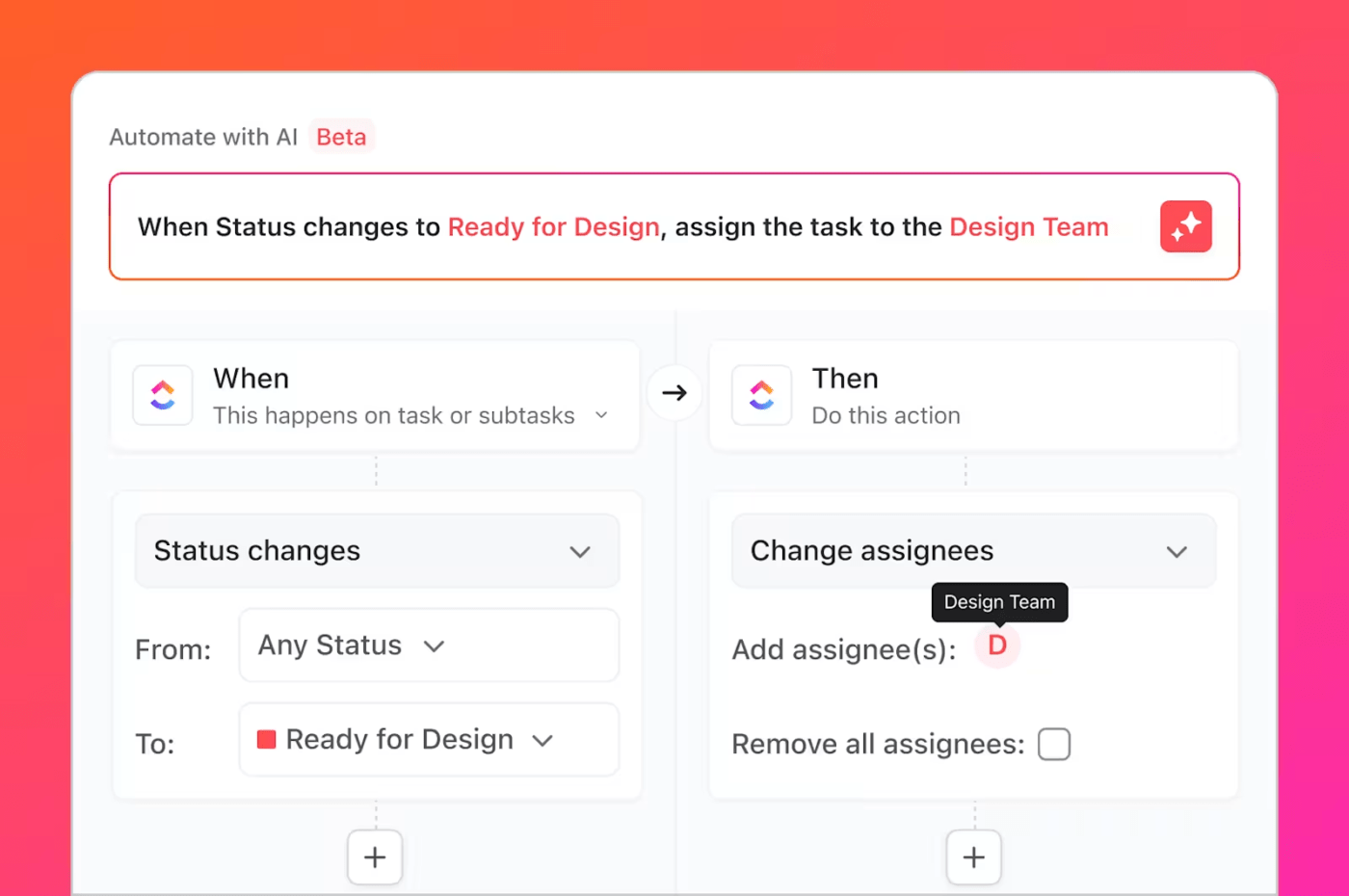
Let’s say you complete a Task, “Update Privacy Consent Form”. An automation triggers a compliance review task, assigns it, records the decision, and notifies all relevant stakeholders. No one forgets steps, there are no back-and-forth delays, and you maintain traceability.
💡 Pro Tip: Start small. Automate your most repetitive but risk-sensitive steps (e.g. approvals) first. Then expand. You can also build these automations in ClickUp using natural language prompts via ClickUp Brain.
Step 5: Create real-time ClickUp Dashboards for executive and regulatory visibility
To keep everyone aligned and accountable, build shared Dashboards in ClickUp. Dashboards can bring in cards that let you track goal status, overdue tasks, ROI of your initiative, and other make-or-break metrics in a convenient, customizable view.
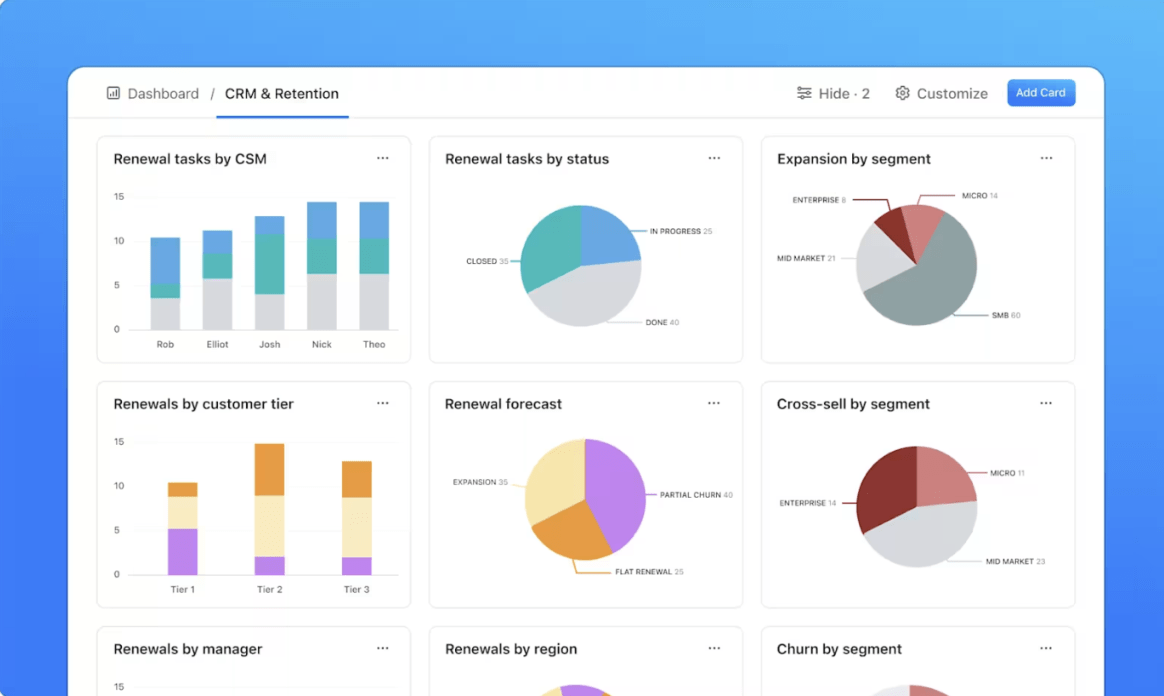
In the healthcare scenario, you might maintain two dashboards:
- Executive Dashboard showing high-level metrics (readmissions, patient satisfaction, compliance issue count)
- Operational Dashboard showing departmental throughput, open compliance tasks, and bottlenecks, etc.
Because dashboards auto-refresh as your data updates, your leadership always sees the live state without waiting for weekly reports or email dumps.
Step 6: Use ClickUp Brain to generate summaries, risk reports, and updates
Finally, use ClickUp Brain to make sure everyone can access the information they need—when they need it. It can
- Summarize long Docs or ClickUp Chat threads
- Generate action items based on your discussions
- Order strategic priorities based on urgency and importance, and
- Help with risk management by creating status reports after searching and gathering relevant data from your workspace
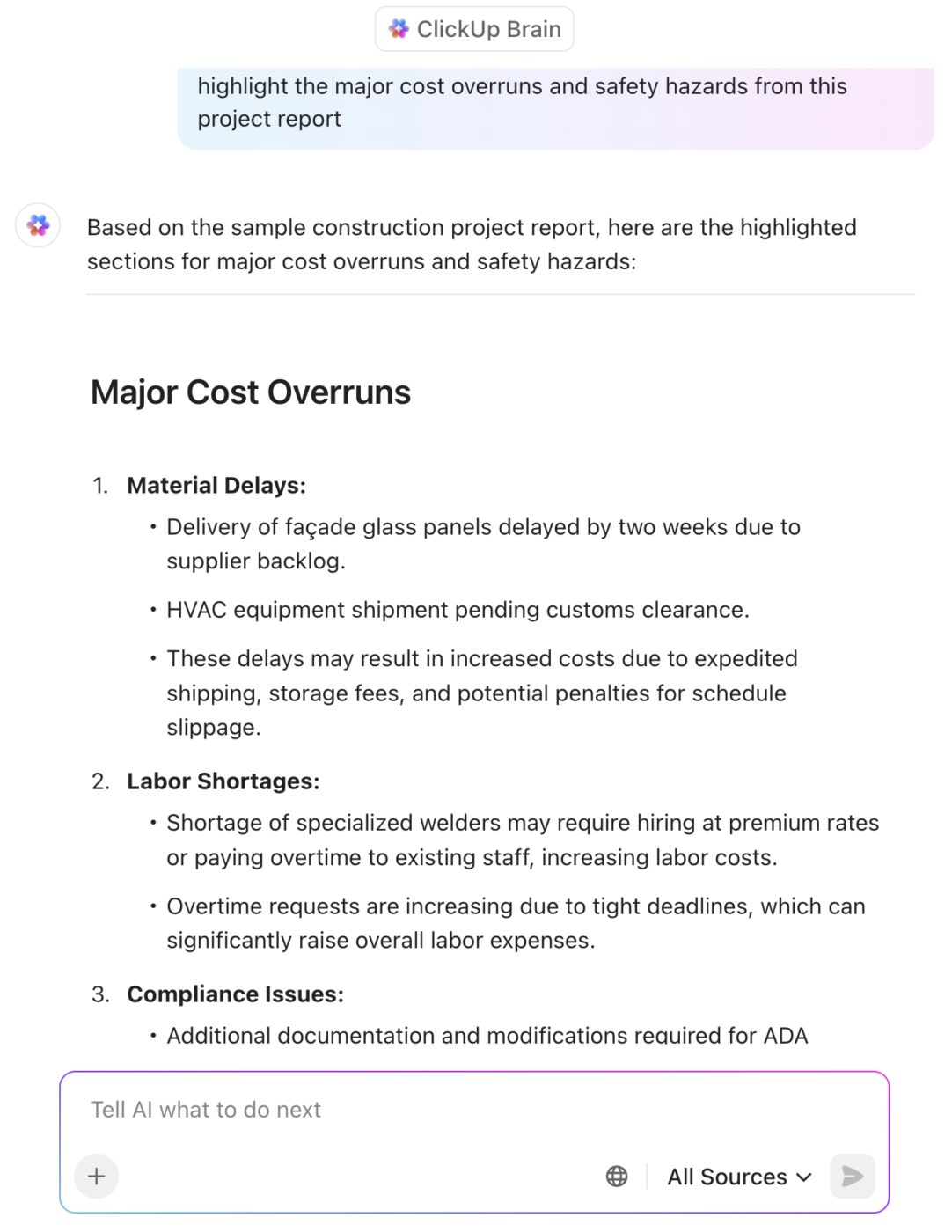
In practice, at the end of each month, you can ask Brain to “summarize progress vs. goals,” highlight risks in compliance, draft a stakeholder update, or suggest which initiatives to slow or accelerate. That saves hours of manual copy-pasting for sharing updates and helps you shift focus where it matters.
Here are our best tips on using AI for project management:
Common Mistakes in Industry-Specific Initiative Execution
These are some of the pitfalls we’ve seen teams repeatedly fall into. Avoiding them (or catching them early) makes your playbook far more likely to succeed.
Over-applying generic frameworks without tailoring
Many organizations adopt a framework (for example, OKRs, Balanced Scorecard, Porter’s Five Forces, etc.), apply it “as is,” and expect it to perform in their context. But industries differ—compliance, customer dynamics, and operational constraints all vary. When you fail to tailor, you run the risk of irrelevant KPIs, misaligned incentives, and slow uptake.
Ignoring compliance and regulatory nuances
Regulations are often non-negotiable. If your playbook skips or underweights compliance steps, you’ll hit delays, fines, or need to spend more time on rework. Also, regulatory changes happen; what was compliant last year may not be now.
Misaligning stakeholder communication with cultural context
What works in a fast-paced SaaS environment (frequent standups, transparent dashboards, decentralization) may fail in a regulated industry or a culture that values hierarchy. If you copy communication styles without adapting to your audience, you’ll hit resistance, misinterpretation, or inertia.
Underestimating the role of workforce engagement
Making plans and setting up systems can only get you so much traction. Strategic initiatives are successful only when real people do the real work.
If you assume people will follow just because a solid strategy says so, or that training alone suffices, you miss addressing themes such as morale, buy-in, feedback, and change fatigue. When workforce engagement is low, initiatives limp along or quietly start to fail.
The fix? Build your playbook around your real-world context—your regulations, your customers, your team culture, and how ready your people are for change. The best organizations don’t try to get everything perfect on day one. They learn fast, update their playbooks, and use those lessons to move more quickly the next time.
Case Studies: Strategic Initiatives by Industry
Here are some successful case studies from different industries to inspire your own strategic clarity:
1) Healthcare: Intermountain Health (AI to spot at-risk patients)
⚠️ Problem: Intermountain needed to find patients at risk of chronic conditions earlier, so care teams could intervene before complications and high-cost episodes. Traditional rules and manual reviews were slow and missed signals.
🛠️ Approach: Intermountain used AI-enhanced data analysis (clinical + claims + social determinants) to generate risk scores and surfaced actionable patient lists for outreach. The program tied models into clinical workflows so care teams received prioritized patient lists with suggested interventions and documentation checklists.
🎯 Results: The initiative improved identification accuracy, sped up outreach, and supported measurable improvements in care management metrics (fewer missed opportunities for early intervention). The program helped Intermountain win recognition for how analytics were operationalized into care delivery rather than kept as research.
❇️ Why it worked: The AI models were trained on domain-specific inputs and embedded into day-to-day clinical workflows. That meant clinicians got timely, relevant actions with the evidence and approvals required, lowering friction and increasing adoption.
2) Finance: BBVA (Digitalization for customer-centricity)
⚠️ Problem: BBVA (Banco Bilbao Vizcaya Argentaria, a Spanish multinational financial services company), needed to transform itself into a more modernized and customer-centric bank. Its legacy systems, slow onboarding processes, and fragmented customer journeys made it hard to scale digital services.
Many customers still used non-digital channels; digital engagement and sales were lagging, especially in markets demanding fast, seamless experiences. BBVA faced the twin challenge of modernizing technology (cloud, data, AI) while also overhauling how customers interact with the bank—all without compromising regulation, security, or consistency across geographies.
🛠️ Approach: BBVA partnered with Accenture to build a new digital sales model. They brought together first-party data (customer activity, behavior) and new external sources to understand the full customer journey. This enabled more precise segmentation, insights into lifetime profitability, and predictive modeling.
They also dramatically sped up onboarding: using AI-based facial recognition, text analytics, and real-time connections to external data sources to verify account applicants via mobile. Simultaneously, they focused on digital channels, personalizing content and offers, and ensuring marketing, content, and SEO supported the digital journey.
🎯 Results:
- In 2023, BBVA added 11.1 million new customers, and 65% of those came through digital channels
- Over the last four years, they saw 100% growth in digital sales
- The bank’s cost-to-income ratio dropped to 41.7%, which is strong among European banks
3) Manufacturing: Siemens Erlangen (Digital Twin for Faster Optimizations)
⚠️ Problem: Siemens’ Electronics Factory in Erlangen faced challenges in optimizing production for efficiency, energy use, and speed to market. Traditional trial-and-error adjustments on the shop floor were slow, costly, and limited the factory’s ability to respond quickly to changing product demands.
🛠️ Approach: Siemens implemented the digital twin technology—virtual replicas of production lines that simulate operations, test changes, and optimize processes before real-world strategy implementation. Real-time data from machines and sensors feeds into the digital twins, enabling dynamic adjustments in strategic planning.
🎯 Results: The factory achieved
- 40% faster time-to-market
- 50% higher production output
- 50% lower energy consumption per product, and
- 40% reduced material circulation
Siemens Erlangen was also recognized as a Digital Lighthouse by the World Economic Forum for its sustainable, digitally transformed operations.
❇️ Why it worked: The digital twins integrated simulation, real-time data, and predictive analytics directly into daily manufacturing workflows, allowing business units to optimize decisions quickly and reduce risk before physical changes were applied.
The Future of Industry-Specific Playbooks
So, where are industry-specific playbooks headed?
Our research suggests that industry-specific playbooks are shifting from static PDF/Docs to executable platforms that combine: runbooks (Docs), visual flows (whiteboards/digital twins), live KPIs (dashboards), and embedded AI agents in a Converged AI Workspace like ClickUp.
This is happening because organizations are rapidly integrating generative AI and predictive models directly into workflows, instead of treating AI as a separate layer.
In order to extract sustained value from such strategic AI investments, leaders are combining tech modernization with process redesign, data foundations, and workforce upskilling.
Businesses are also looking at using hybrid project management methodologies for adaptive planning and smarter execution of their playbooks. In 2024, 60% of project managers had already gone hybrid.
Finally, resilience planning is also becoming a core component of industry-specific playbooks. Amid rising threats from climate change, cyber attacks, and political crises, businesses want to ensure they can continue operating during and after such disruptions.
The bottom line?
Across industries, strategic execution playbooks are evolving to meet the demands of a rapidly changing business environment, one where every organization needs to have contingency plans for multiple “what if” scenarios.
📚 Also Read: How to Implement Strategic Project Management
Turning Static Strategy into Evolving Execution with Industry-Specific Playbooks
Industry-specific playbooks are where strategy meets execution: they give you the templates, rules, and repeatable workflows adapted to the realities of your sector.
AI multiplies the value of those playbooks. Technologies such as predictive analytics, industry-tuned dashboards, workflow automation, and sentiment tools that help you find risks earlier, make faster decisions, and keep humans accountable. But the win goes to teams that pair AI with strong data foundations, governance, and workforce readiness.
If you’re building playbooks to run strategic initiatives, make them living, measurable, and embedded in the tools your teams use every day.
ClickUp’s Converged AI Workspace provides you with the practical building blocks (Docs, Whiteboards, Goals, Automations, Dashboards, and Brain) to create an executable, auditable playbook—so you can go to your strategy’s outcomes faster and with fewer surprises.
The best time to start executing was yesterday. The second-best time is now.
Get ClickUp for free and get started right away!
Frequently Asked Questions (FAQs)
A strategic initiative playbook is a repeatable guide that helps organizations turn strategy into action. It lays out your vision, workflows, roles, timelines, and KPIs in one structured framework.
Industry-specific playbooks adapt proven frameworks to your sector’s realities — regulations, customer expectations, and operational nuances. While generic strategy models like OKRs or Balanced Scorecards offer structure, they often miss context.
Absolutely. AI can analyze industry data, performance metrics, and regulatory patterns to recommend workflows, KPIs, and risk controls that match your context. Predictive analytics highlight emerging risks or opportunities, while generative AI tools summarize insights, automate documentation, and even build scenario plans.
You measure success by linking every action to outcomes that matter in your sector—not just generic KPIs. For instance, a manufacturing playbook tracks efficiency and uptime; finance measures regulatory compliance and risk mitigation; SaaS teams track retention and ARR growth.
ClickUp brings every piece of your playbook into one connected workspace. You can document your strategy in Docs, map workflows in Whiteboards, turn goals into measurable outcomes with Goals, automate approvals and compliance with Automations, visualize progress in Dashboards, and use ClickUp Brain for instant summaries and risk reports.

